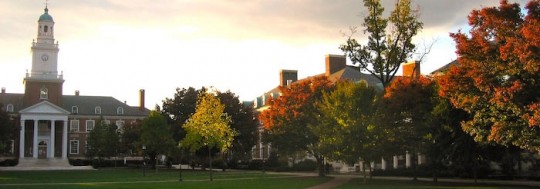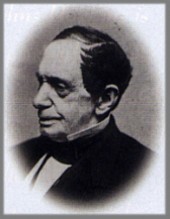About The Johns Hopkins University.
Sections for Johns Hopkins University
- About The Johns Hopkins University.
- About The Johns Hopkins University. History.
- About The Johns Hopkins University. Facts And Statistics.
About The Johns Hopkins University.
> Johns Hopkins University Mission Statement.
The mission of The Johns Hopkins University is to educate its students and cultivate their capacity for life-long learning, to foster independent and original research, and to bring the benefits of discovery to the world.

> Who Was Johns Hopkins
First things first: why the extra “S”? Because his first name was really a last name.

Johns Hopkins’ great-grandmother was Margaret Johns, the daughter of Richard Johns, owner of a 4,000-acre estate in Calvert County, Md. Margaret Johns married Gerard Hopkins in 1700; one of their children was named Johns Hopkins.
The second Johns Hopkins, grandson of the first, was born in 1795 on his family’s tobacco plantation in southern Maryland. His formal education ended in 1807, when his parents, devout Quakers, decided on the basis of religious conviction to free their slaves and put Johns and his brother to work in the fields. Johns left home at 17 for Baltimore and a job in business with an uncle, then established his own mercantile house at the age of 24.
He was an important investor in the nation’s first major railroad, the Baltimore and Ohio, and became a director in 1847 and chairman of its finance committee in 1855.
Hopkins never married; he may have been influenced in planning for his estate by a friend, philanthropist George Peabody, who had founded the Peabody Institute in Baltimore in 1857.
In 1867, Hopkins arranged for the incorporation of The Johns Hopkins University and The Johns Hopkins Hospital, and for the appointment of a 12-member board of trustees for each. He died on Christmas Eve 1873, leaving $7 million to be divided equally between the two institutions. It was, at the time, the largest philanthropic bequest in U.S. history.

> A Brief History of JHU.
The Johns Hopkins University opened in 1876, with the inauguration of its first president, Daniel Coit Gilman. “What are we aiming at?” Gilman asked in his installation address. “The encouragement of research … and the advancement of individual scholars, who by their excellence will advance the sciences they pursue, and the society where they dwell.”
The mission laid out by Gilman remains the university’s mission today, summed up in a simple but powerful restatement of Gilman’s own words: “Knowledge for the world.”
What Gilman created was a research university, dedicated to advancing both students’ knowledge and the state of human knowledge through research and scholarship. Gilman believed that teaching and research are interdependent, that success in one depends on success in the other. A modern university, he believed, must do both well. The realization of Gilman’s philosophy at Johns Hopkins, and at other institutions that later attracted Johns Hopkins-trained scholars, revolutionized higher education in America, leading to the research university system as it exists today.
After more than 130 years, Johns Hopkins remains a world leader in both teaching and research. Eminent professors mentor top students in the arts and music, the humanities, the social and natural sciences, engineering, international studies, education, business and the health professions. Those same faculty members, and their research colleagues at the university’s Applied Physics Laboratory, have each year since 1979 won Johns Hopkins more federal research and development funding than any other university.
The university has nine academic divisions and campuses throughout the Baltimore-Washington area. The Krieger School of Arts and Sciences, the Whiting School of Engineering, the School of Education and the Carey Business School are based at the Homewood campus in northern Baltimore. The schools of Medicine, Public Health, and Nursing share a campus in east Baltimore with The Johns Hopkins Hospital. The Peabody Institute, a leading professional school of music, is located on Mount Vernon Place in downtown Baltimore. The Paul H. Nitze School of Advanced International Studies is located in Washington’s Dupont Circle area.
The Applied Physics Laboratory is a division of the university co-equal to the nine schools, but with a non-academic, research-based mission. APL, located between Baltimore and Washington, supports national security and also pursues space science, exploration of the Solar System and other civilian research and development.
Johns Hopkins also has a campus near Rockville in Montgomery County, Md., and has academic facilities in Nanjing, China, and in Bologna, Italy. It maintains a network of continuing education facilities throughout the Baltimore-Washington region, including centers in downtown Baltimore, in downtown Washington and in Columbia.
When considered in partnership with its sister institution, the Johns Hopkins Hospital and Health System, the university is Maryland’s largest employer and contributes more than $10 billion a year to the state’s economy.

> Facts At A Glance.
- The Johns Hopkins University, founded in 1876, was the first university in the Western Hemisphere based on the European research institution, with a mission both to teach and to advance human knowledge through discovery. Its establishment revolutionized U.S. higher education; today, it remains a world leader in education, research and patient care.
- The university is named for its initial benefactor, Baltimore merchant Johns Hopkins, whose $7 million bequest — the largest U.S. philanthropic gift to that time — was divided evenly to finance the establishment of the university and The Johns Hopkins Hospital.
- Today, the university enrolls nearly 20,000 full-time and part-time students on three major campuses in Baltimore, one in Washington, D.C., one in Montgomery County, Md., and facilities throughout the Baltimore-Washington area and in China and Italy.
- The headquarters campus — Homewood — has more than 4,700 full-time undergraduates and about 1,600 full-time graduate students in two schools, the Krieger School of Arts and Sciences and the Whiting School of Engineering.
- Johns Hopkins has offered courses for part-time students since its founding, and established a formal division to administer continuing education in 1909. Today, part-time students — primarily master’s degree candidates — account for nearly 40 percent of Johns Hopkins enrollment.
- The university employs about 27,000 people in full-time, part-time and temporary positions. It is one of Maryland’s largest private employers.
- The Johns Hopkins Institutions — that is, the university and the Johns Hopkins Health System, a separate corporation — together constitute the state’s largest private employer.
- Johns Hopkins ranks first among U.S. universities in receipt of federal research and development funds. The School of Medicine ranks first among medical schools in receipt of extramural awards from the National Institutes of Health. The Bloomberg School of Public Health is first among its peers in research support from the federal government.


















